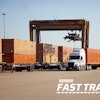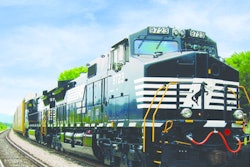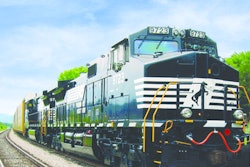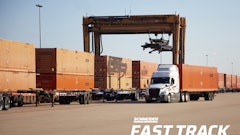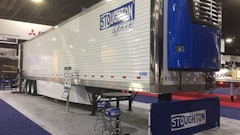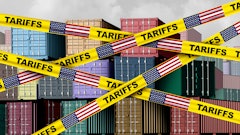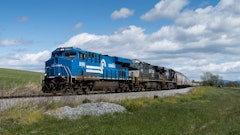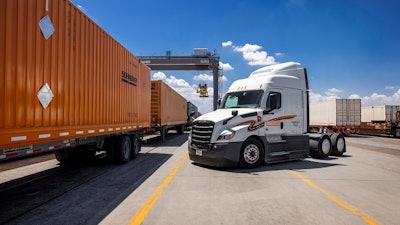
Traditionally, food and beverage shippers have relied on over-the-road shipping to ensure the freshness and consistency of their deliveries. However, recent market conditions have pushed these shippers to re-consider their options, and positive developments in intermodal shipping are offering new opportunities.
Intermodal has been growing in recent years, and as U.S. companies have been managing uncertain truckload capacity and the impacts of tariffs, including the need to pull through inventory quickly and save costs, there has been a continued and notable uptick in intermodal usage in the first half of 2025.
A driving factor for many shippers making the change to intermodal is managing costs. At a time when both shippers and their consumers are worried about rising costs due to tariffs and inflation, every penny counts. In times when capacity is tight, shippers rely on intermodal to move more freight for less. In fact, one train can haul as much as 300 truckloads of freight with four times less fuel than over-the-road transportation.
Cost is only one piece of the puzzle, though. Shippers are also looking for consistency and there has been uncertainty around driver capacity, stemming from new regulations as well as rising carrier costs that are significantly impacting smaller owner-operators.
Finally, as demonstrated by traffic jams at the border this spring or volume surges at the ports, pulling forward more inventory can be difficult to accomplish quickly on trucks. Intermodal offers increased capacity, making it easier and more efficient to move large quantities of inventory across the border.
As more shippers are drawn to the benefits of intermodal, it is critical that they understand the nuances of this transportation mode to maximize the benefits. Here are four considerations for food logistics executives planning to convert from over-the-road or interested in exploring the benefits of intermodal.
Ensuring your product arrives on time and fresh
Train frequency and priority access to rail lines are some ways to evaluate if a network will be able to deliver on time.
Intermodal was historically viewed as a slower option when compared to over-the-road. Food shippers might have overlooked intermodal; when you’re transporting food and beverages, the transportation windows are tight, and in the past, intermodal was slower and less consistent, with trains taking days to deliver freight to its destination.
But today, some providers are measuring their intermodal delivery times – even long-distance shipments – in hours, not days, with an intermodal offering performing at an elevated level of service that has outpaced industry standards for consistency and speed.
Shippers can now find intermodal providers who run trains daily, and with train lines that run seven days per week, missing a Friday cutoff no longer means shippers' goods get delayed until Monday. This increasing speed and reliability of deliveries is especially important for food and beverage shippers, where freshness matters.
Shippers should also consider whether there are direct connections to major hubs of consumption or distribution and how regularly trains are scheduled. Interchanges and crew changes can lead to delays. These factors are vitally important to business operations – 67% of shippers say service level and reliability are the top factors when choosing a freight partner.
Security for high-value cargo
Food and beverage commodities experienced substantial increases in theft activity in the first quarter of 2025, according to CargoNet. These increases were higher in meat products (242% increase) and beverages (65% increase for alcoholic, 94% increase for non-alcoholic).
We often say, “cargo at rest is cargo at risk of theft.” To decrease the risk of cargo theft, it’s important to evaluate the number of interchanges along a shipping route—fewer is better, with zero being ideal. Fewer interchanges mean fewer delays due to crew changes or scheduling conflicts. Shippers should also consider how often, if ever, the train stops. For example, northbound routes from Mexico that operate nonstop can avoid delays and risk at the border. Additionally, it’s worth asking how many carriers use a particular border-crossing bridge. If your shipping company is the sole user, your freight is more likely to receive priority and avoid delays caused by waiting for other customers’ cargo to cross the bridge.
And don’t forget: working with a carrier that has procedures tailored to intermodal shipping – things like container locks, and tracking and visibility tools – should be a top priority in conversion planning.
It's important to remember that more is at stake than just the cost of the products when it comes to cargo security. Many shippers, including food and pharmaceutical manufacturers, are at risk when it comes to product safety, brand reputation and lost opportunity at the store shelf if a theft results in a recall or other regulatory issue.
Optimizing for seasonality
Like many other industries, food and beverage experiences a high level of seasonality. This is already top of mind for produce, but even beverages and snacks experience a degree of seasonality, such as snacks being in demand for Super Bowl, holiday and picnic seasons.
Shippers can work with carriers to map out and plan their volumes and reduce the degree of shipping spikes and valleys to reduce premium pricing on unpredictable loads. They should also interview logistics providers carefully to determine if those providers are flexible enough to overcome inevitable seasonality based on capability and capacity. In intermodal, that means scale by weight but also the scale of the network capacity.
Equipment consistency on both sides of the journey
It is also important to plan for equipment needs on both sides of the rail journey. For instance, a heavy beverage load might require a carrier scaling to 45,500 pounds, but the third-party dray at the destination might use heavier equipment, resulting in a 42,500-pound payload.
Ensure consistency in chassis, containers and tractors across the entire intermodal trip and at the destination to consistently scale loads and avoid delays or unexpected costs for additional equipment. This is particularly important if there is a third-party carrier involved for drayage, compared to a shipping arrangement that uses the same company at both ends, which can adequately plan for the load.
Working with intermodal carriers that utilize an asset-based equipment model can increase consistency, eliminate guesswork and ensure maximum payload at every stage of the journey.
Closing thoughts
One final tip for successful intermodal conversion: partner with a provider that offers a dedicated intermodal onboarding team. This specialized support can be crucial for setting your business up for long-term success — especially in today’s crowded marketplace and amid rising demand for intermodal services.
Last year, according to a report from the Intermodal Association of North America (IANA), total North American intermodal volume rose 8.5% in 2024. Plus, the Asociación Mexicana del Transporte Intermodal (AMTI), Mexico’s total cross-border intermodal market grew 17%, and Schneider saw its intermodal services outpace the market over the same period, speaking to significant growth.
As shippers look for speed and reliability, with the added benefits of optimized costs, larger loads and more security, intermodal offers a reliable option to weather supply chain disruptions.

